Ever noticed how your wooden floor changes color over time? Sunlight could be the hidden culprit! Curious to know how? Read on!
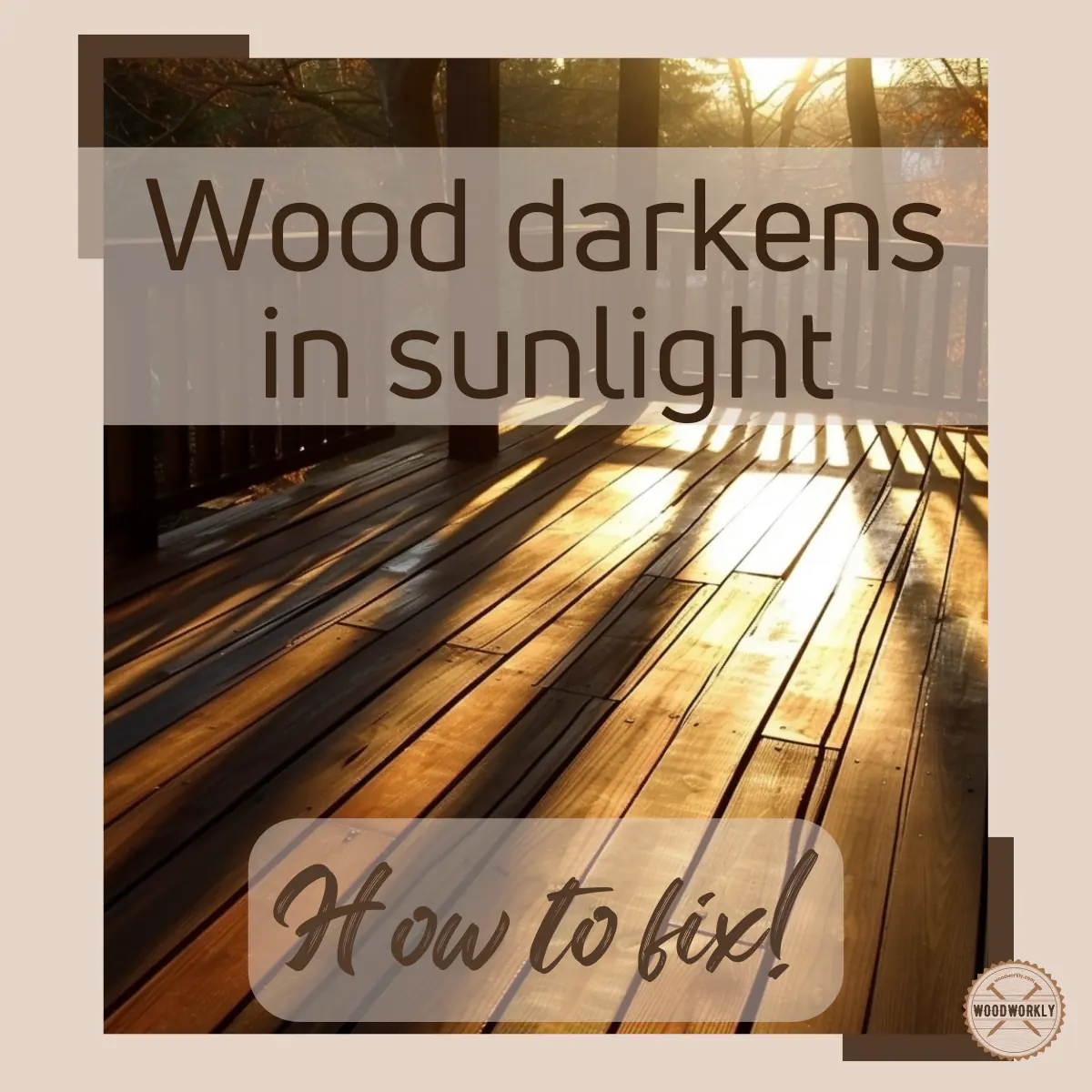
Sunlight is considered one of the main environmental elements that affect the lifespan of wooden furniture and woodwork.
Both indoor and outdoor wooden furniture are exposed to sunlight, which dramatically alters their physical and chemical structures over time.
When it comes to physical appearance, I always wondered about the color change or color fade or darkening that happens in wood projects that are placed outside or faced direct sunlight.
I did some research about this and was able to find some useful info.
So, let’s find out, Does sunlight darken wood?
Yes, sunlight does darken certain types of wood, especially tropical species like Brazilian Cherry. However, it can also bleach and lighten other types, such as Red Oak and Maple. The sun’s UV rays cause these changes, and the wood’s reaction also depends on the type of finish applied.
But there’s a lot more we need to learn about how sunlight affects the wood color over time.

So, in this article, I’ll explore, how does sunlight darken the wood, what happens when you leave the wood in the sun, and many more.
Plus, I’ll answer some frequently asked questions as well.
Just keep reading!
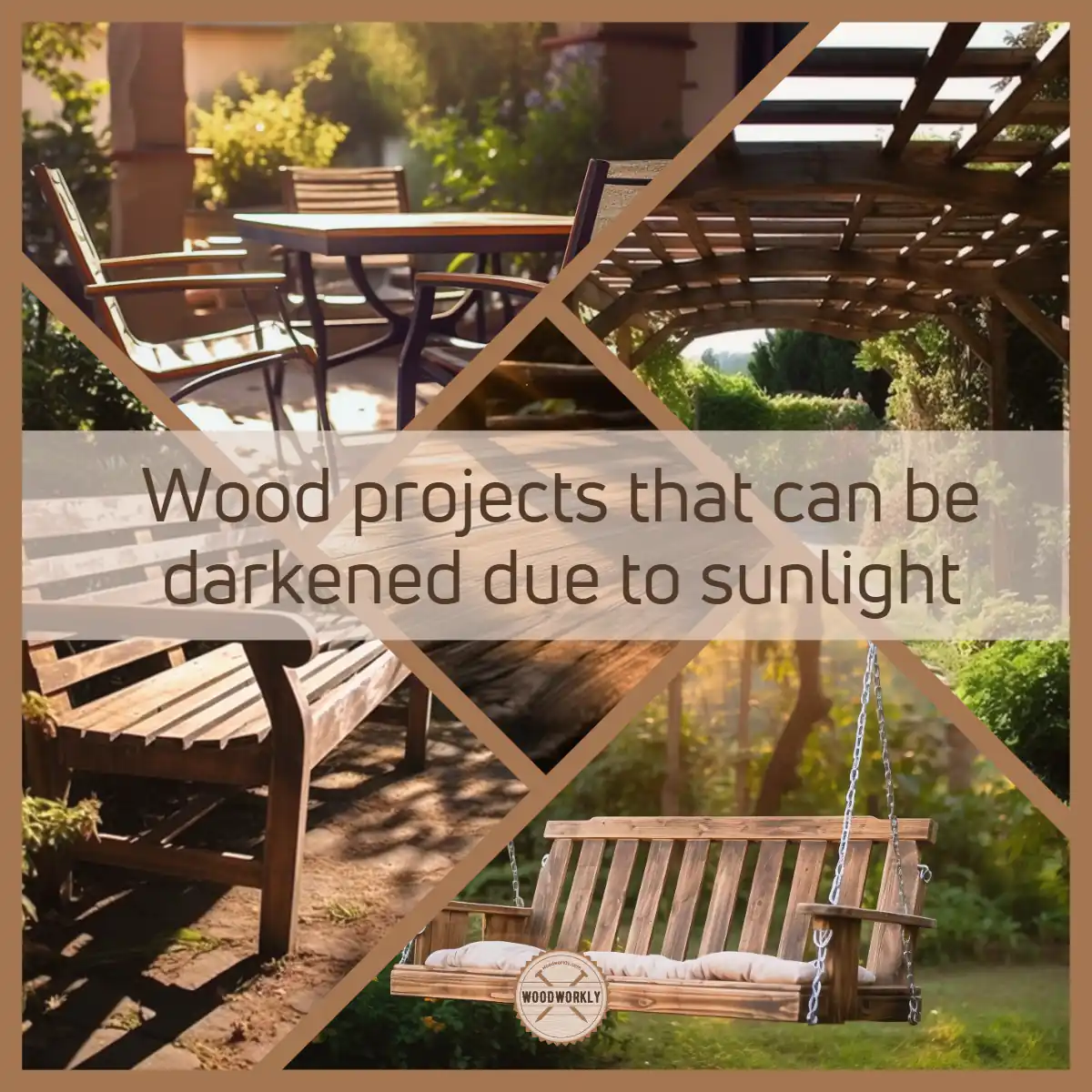
Why Does Sunlight Darken Wood?
Sunlight darkens wood since wood is highly photosensitive, which essentially means it reacts to sunlight.
This reaction can be likened to how our skin responds when we spend a day at the beach.
Depending on your skin type, you might tan quickly, slowly, or even burn. Similarly, different types of wood react to sunlight in unique ways.
To illustrate this, imagine placing a piece of unfinished wood out in direct sunlight for a short time, with part of it covered.
You would notice a significant color change in the exposed area due to the effects of the sun’s ultraviolet (UV) rays.
Wood Species and Their Responses to Sunlight
Just as the degree of sun tanning varies among different skin types, the speed and extent of wood darkening depend on the type of wood.
Tropical, exotic woods used in floorings, such as Brazilian Cherry or Tigerwood, react to UV exposure very fast, often darkening to a much deeper shade.
On the flip side, domestic woods like Red Oak, Maple, and Hickory generally bleach out and become lighter under the sun, and at a much slower rate.
These changes can bring about a charming variation in your wooden items or floors, but they can also be a cause of concern if the color change is drastic or undesired.
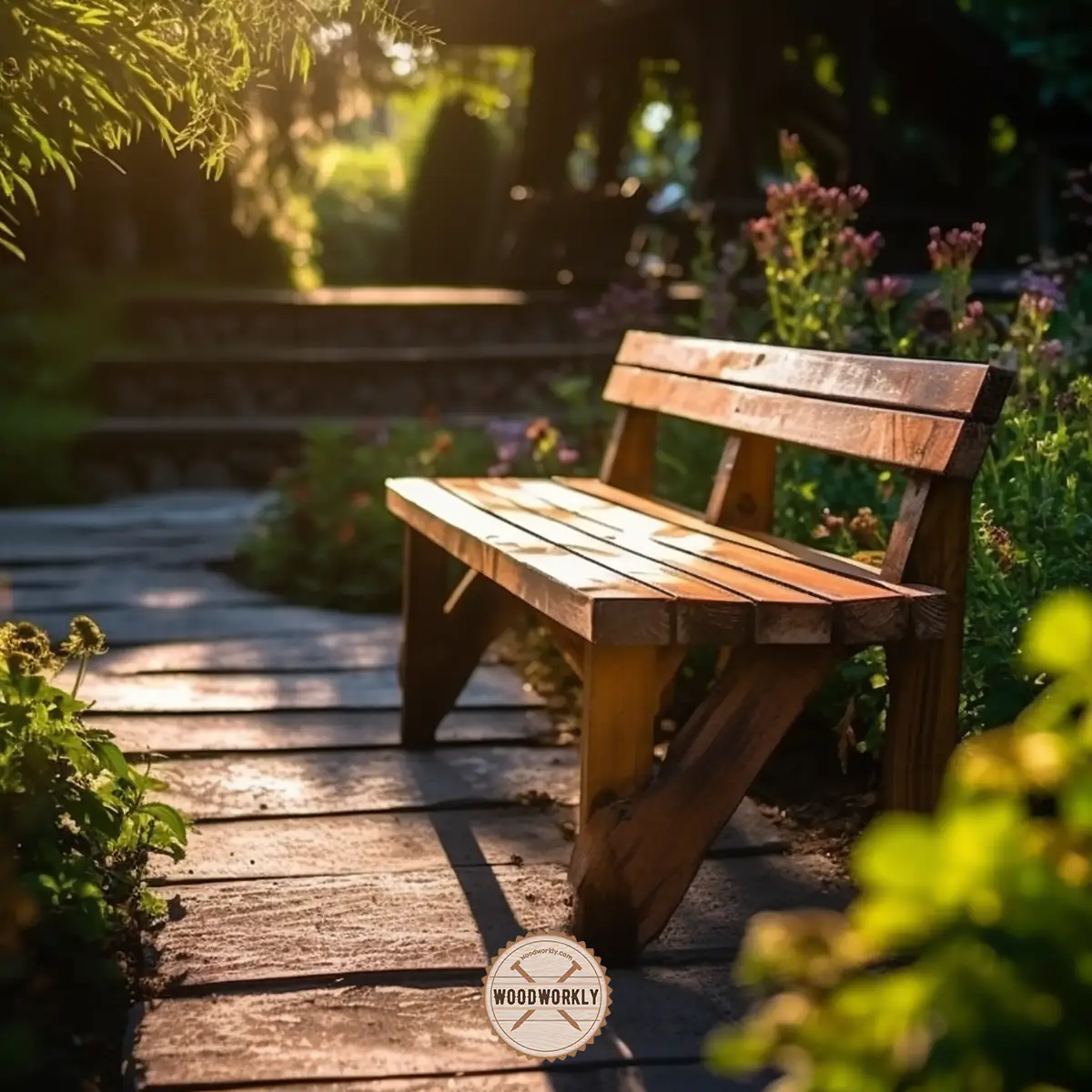
The Role of Wood Finishes
It’s not just the type of wood that determines how it reacts to sunlight.
The type of finish on the wood also plays a significant role in how it will react to light exposure.
UV light, visible light, and infrared (IR) light, which causes solar heat, can react with the finish, gradually causing it to darken or turn yellowish.
For instance, hardwood floors with an oil-based polyurethane finish can turn an orangey/yellow color over time due to prolonged exposure to these light forms.
This effect is similar to how fabrics on your sofa or the paint on your car may fade or discolor under the sun.
Can We Prevent Sunlight from Darkening Wood?
While it’s impossible to completely prevent the effects of sunlight exposure on wood, there are measures we can take to slow down the process and reduce the damage.
For instance, rearranging furniture and floor coverings from time to time can ensure an even exposure and fading.
Using window coverings or films can limit the amount of harmful light reaching the wood.
Additionally, choosing finishes with UV inhibitors or using low-emissivity (low-E) glass windows can also help.
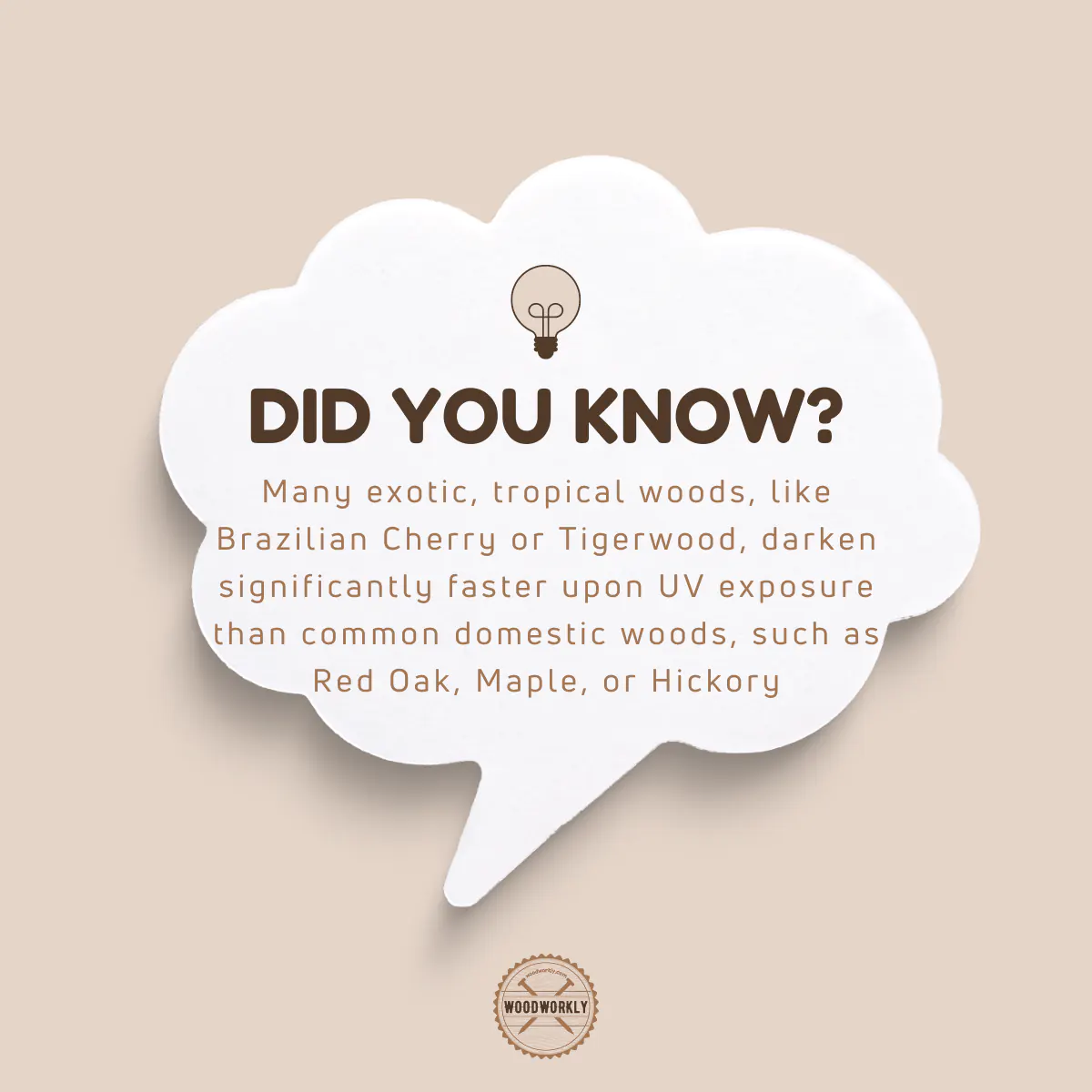
What Does Sunlight Do to Wood?
Sunlight causes to damage the wood and changes its color over time.
If the wood is unfinished or hasn’t applied any coatings the sun damage happens more quickly than finished wood.
But even though your wood is coated, without regular maintenance it will easily get damaged due to exposure to direct sunlight over a long period of time.
As an experienced woodworker, I have noticed that the time that takes for the darkening of the wood over sunlight changes because of the various factors.
So, let’s discuss them in detail.
Factors that Influence the Effects of Sunlight on Wood
As we’ve already established, sunlight can have a profound effect on wood, causing it to darken or lighten over time.
But it’s important to note that the impact of sunlight on wood is not a one-size-fits-all scenario.
Different factors influence how sunlight affects wood, causing variations in the rate and degree of color change.
To better understand this process, let’s delve into the factors that contribute to wood’s response to sunlight.
Type of Wood
The species of wood plays a significant role in determining how sunlight exposure will affect it.
As we mentioned earlier, exotic woods like Brazilian Cherry or Tigerwood tend to react to UV exposure quickly, resulting in a much darker shade.
Meanwhile, domestic woods like Red Oak, Maple, and Hickory usually bleach out and become lighter, albeit at a slower rate.
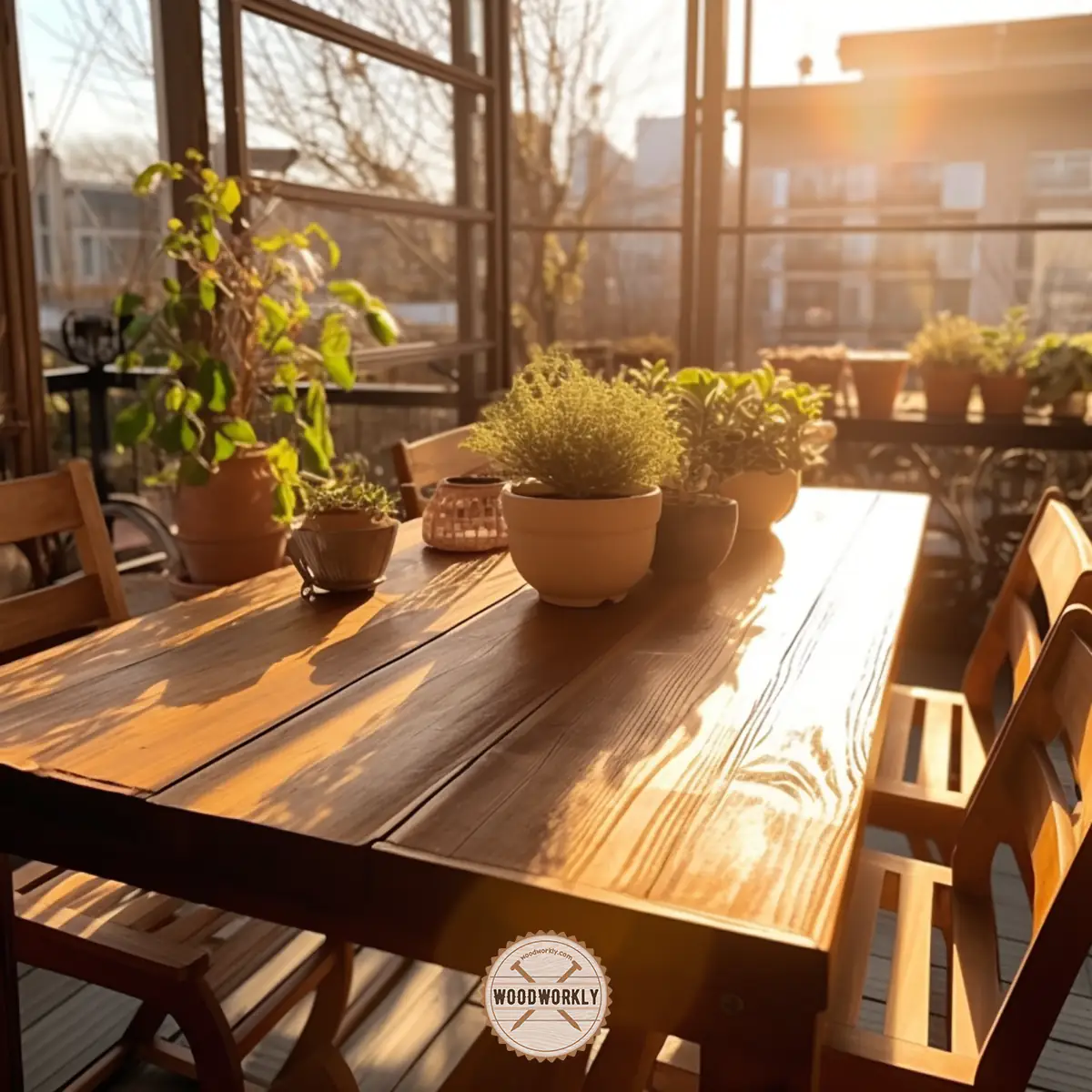
Degree of Sunlight Exposure
Just as with our skin, the amount of time the wood is exposed to sunlight influences the degree of change.
Direct, prolonged exposure to sunlight will cause more noticeable changes in the color of the wood compared to a piece that is occasionally or partially exposed.
Therefore, a wooden floor in a room with large, uncovered windows might darken or lighten more dramatically than a piece of furniture tucked away in a less sun-exposed corner of the house.
Type of Finish Used
The finish used on the wood significantly impacts how the wood reacts to sunlight.
Certain finishes, like oil-based polyurethane, can react with UV, visible, and infrared light, causing them to darken or turn yellowish over time.
Finishes with UV inhibitors, on the other hand, can slow down the fading process, helping to retain the original color of the wood for longer.
The Position and Covering of the Wood
The position of the wood and its coverings play an essential role in its exposure to sunlight.
For instance, wooden floors under a rug or furniture will receive less sunlight and, therefore, change less than the exposed parts.
Similarly, window coverings like blinds, curtains, or window films can reduce the amount of UV and infrared light that reaches the wood, slowing down the process of color change.
Environmental Factors
Environmental factors such as temperature and humidity can also influence how sunlight affects wood.
For example, high temperatures can speed up chemical reactions, which could potentially intensify the effects of sunlight on wood.
On the other hand, high humidity might provide some protection against UV radiation, slowing the process of color change.
While we can’t completely stop the effects of sunlight on wood, understanding the factors that influence these changes can help us manage and mitigate them.
Whether it’s through careful choice of wood and finishes, strategic placement of furniture and coverings, or modifications to our windows, we can extend the beautiful color of our wooden items and keep them looking their best for as long as possible.
And remember, a little sunlight isn’t always a bad thing – it can add character and uniqueness to our wooden pieces, making them truly ours.
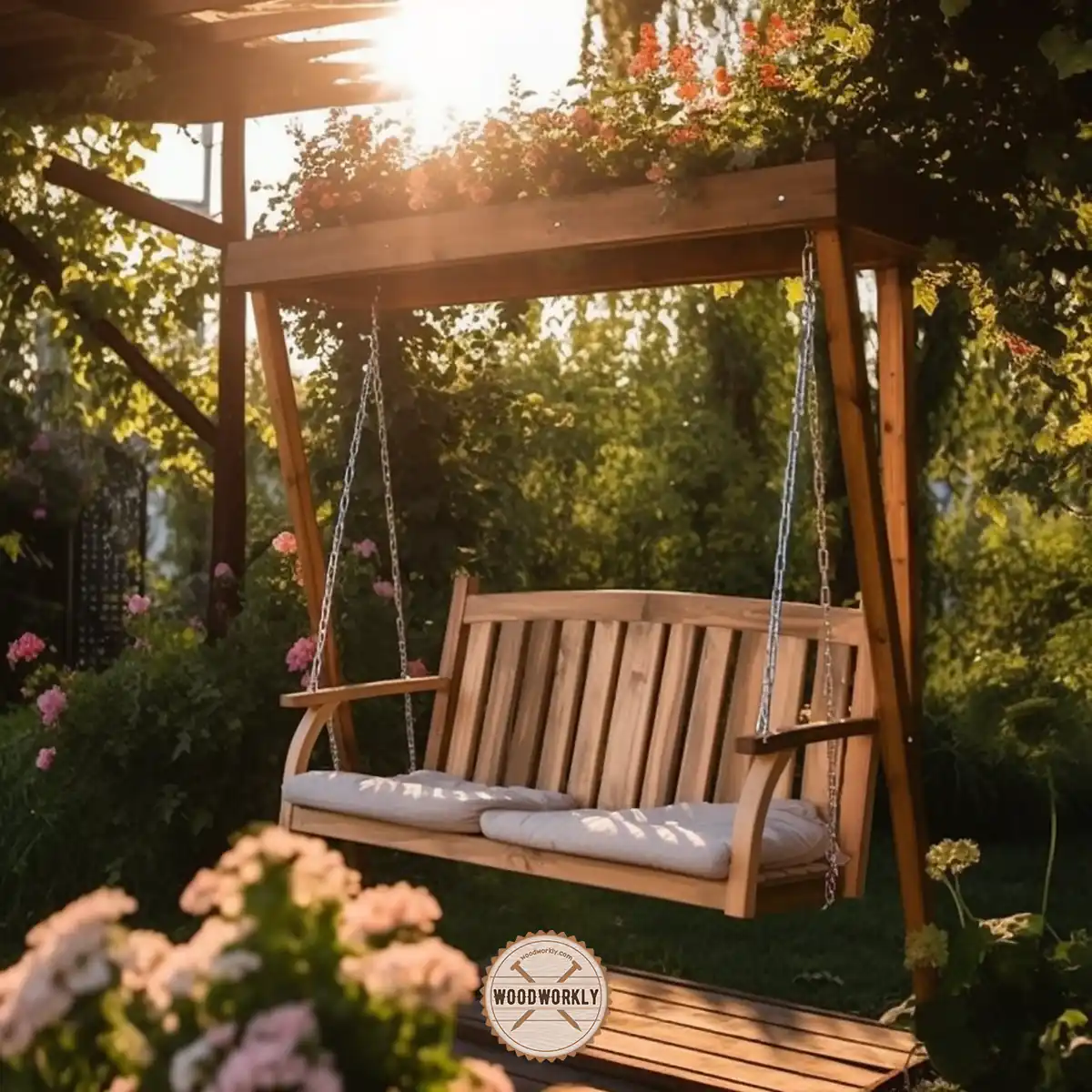
What Happens When You Leave Wood in The Sun?
Most of us have had a personal experience with sun-faded wood.
Maybe it was the beautiful cherry wood dining table that lost its luster over the summer or the wooden deck that gradually changed from a vibrant brown to a dull gray.
It’s all part of the charm and challenge of having wooden items – and it’s all thanks to the sun.
But what really happens when you leave wood in the sun?
Sunlight’s Trifecta: UV, Visible Light, and Infrared Light
When we talk about sunlight, we’re actually talking about three distinct components: ultraviolet (UV) light, visible light, and infrared (IR) light.
Each of these has a unique impact on the wood.
UV Light: This is the main culprit behind the color change in wood. UV light triggers a chemical reaction in the wood, leading to a process known as photooxidation. This process affects the natural lignin in the wood, causing the color to change. For some wood species, this results in darkening, while for others, it can lead to bleaching and a lighter color.
Visible Light: Although not as potent as UV light, visible light can also contribute to the discoloration of wood. This is particularly noticeable in woods that have been dyed or stained, as these treatments can be sensitive to visible light.
Infrared Light: IR light is essentially heat. While it doesn’t directly cause color change, it can contribute indirectly by intensifying the effects of UV and visible light. Plus, excessive heat can dry out the wood, leading to cracking and splitting.
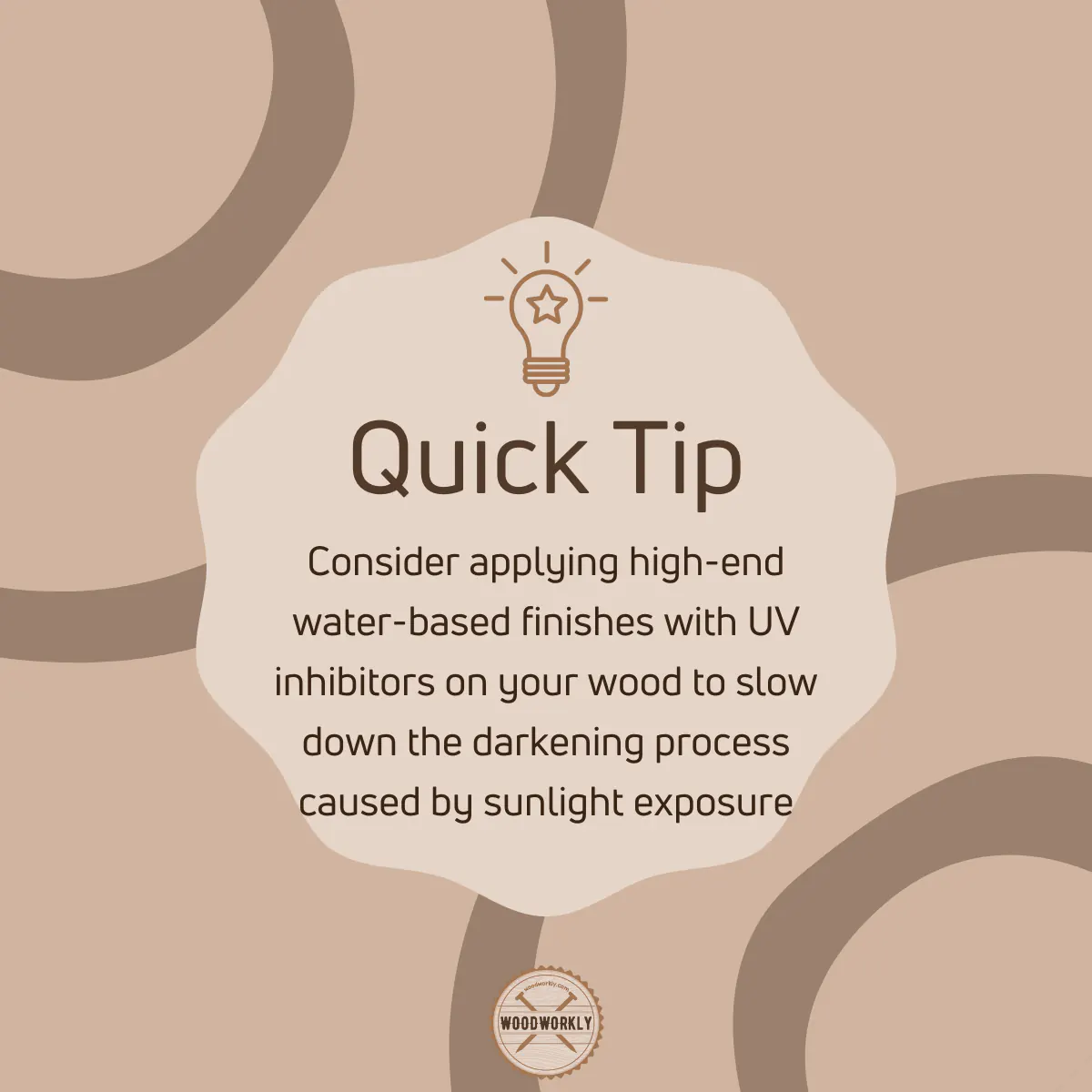
Wood Type Matters
Have you ever noticed how a piece of cherry wood darkens to a deep, rich red when left in the sun while a piece of maple lightens?
That’s because the type of wood determines how it reacts to sunlight.
Generally, exotic woods like Brazilian Cherry or Tigerwood darken upon UV exposure, while domestic woods like Red Oak, Maple, and Hickory tend to lighten.
Discoloration of Finishes
But it’s not just the wood that changes color in the sun – the type of finish on the wood also plays a huge role in this transformation.
Some finishes, like oil-based polyurethane, react with sunlight, turning darker or yellowish over time.
Over a long period of time, this can result in that orange/yellow color that many of us find less than appealing.
Practical Implications: Furniture and Flooring
The implications of these changes can be quite significant, especially for hardwood floors and furniture.
If only part of the floor or furniture is exposed to sunlight, it can lead to uneven fading or darkening.
This can leave you with a patchy-looking floor or a two-toned piece of furniture, neither of which is particularly desirable.
When you leave your loved furniture or woodwork in the sun, nothing happens at the beginning.
But when you continuously leave the wood in the sun or if the wooden furniture is regularly left outside over time, you will notice a color change of the wood drastically.
When you leave the wood in the sun, the light color wood tends to be darkened over time and dark color wood tends to lighten over time.
This happens due to chemical changes that happen inside of the wood because of sunlight.
Generally, most of the wood loses color because of sunlight. Wood is photosensitive and when it is exposed to sunlight the reactions happen.
If you keep unfinished wood in the sun I will darken it faster than the finished wood because the amount of sun radiations hitting the unfinished wood is higher and start discoloration quickly.
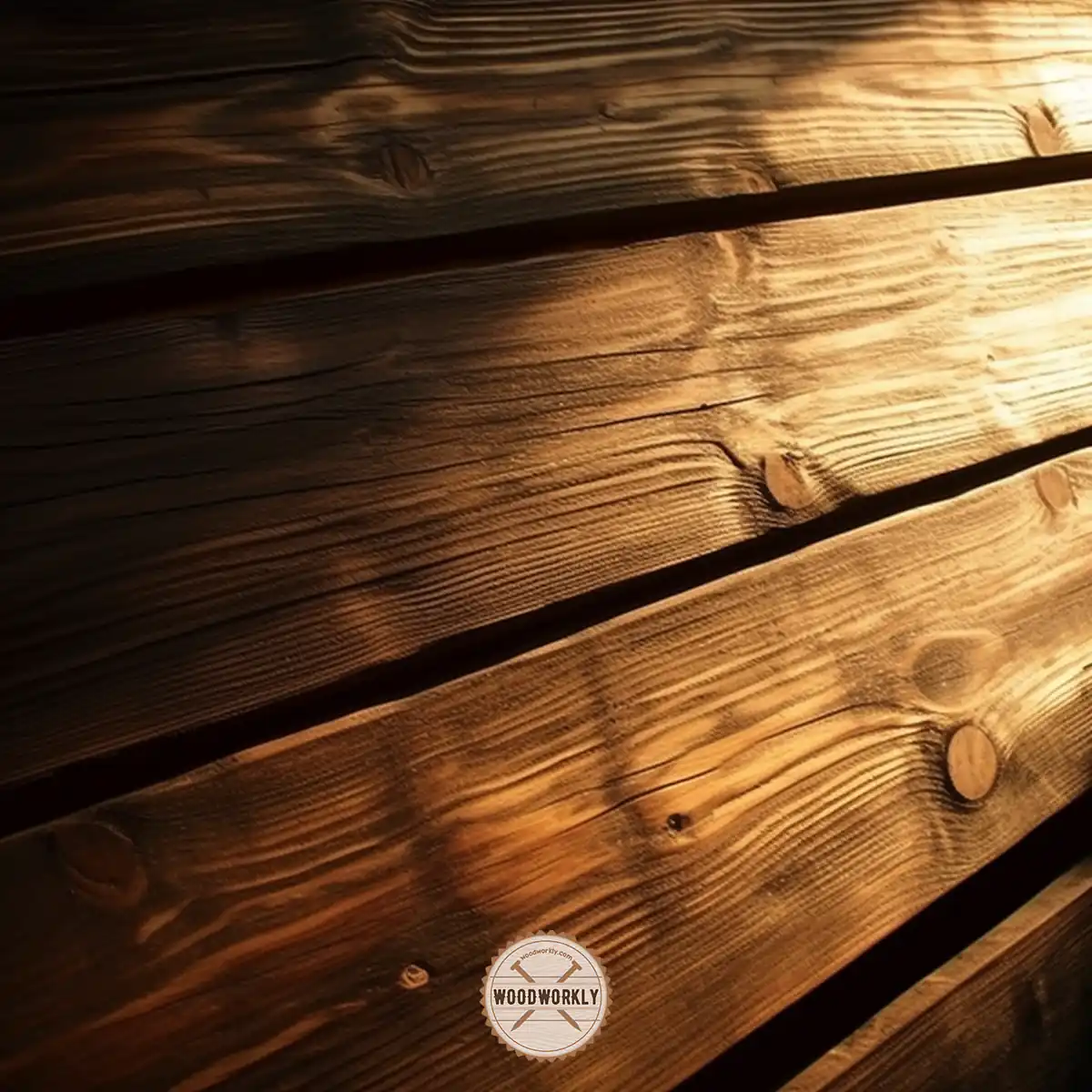
Why Does Wood Change Color in The Sun?
UV light in the sunlight darkens the wood by accelerating the oxidation process inside the wood.
Oxidation processes hold molecules together by building chemical bonds between them.
Also, UV light tends to react with aromatic materials inside the wood which gives the color to the wood and changes its chemical composition.
This will lead to the breakdown of aromatics, and they’ll react with oxygen.
The resulting oxides will further interact and degrade in the end. The bonds built between molecules will absorb and reflect spectra to form different molecules.
The light that reflects because of these chemical reactions are different than the original color of the wood.
This light is known as the color that appeared when you leave the wood in the sun over time. This is how the discoloration happens and this is how sunlight darkens the wood.
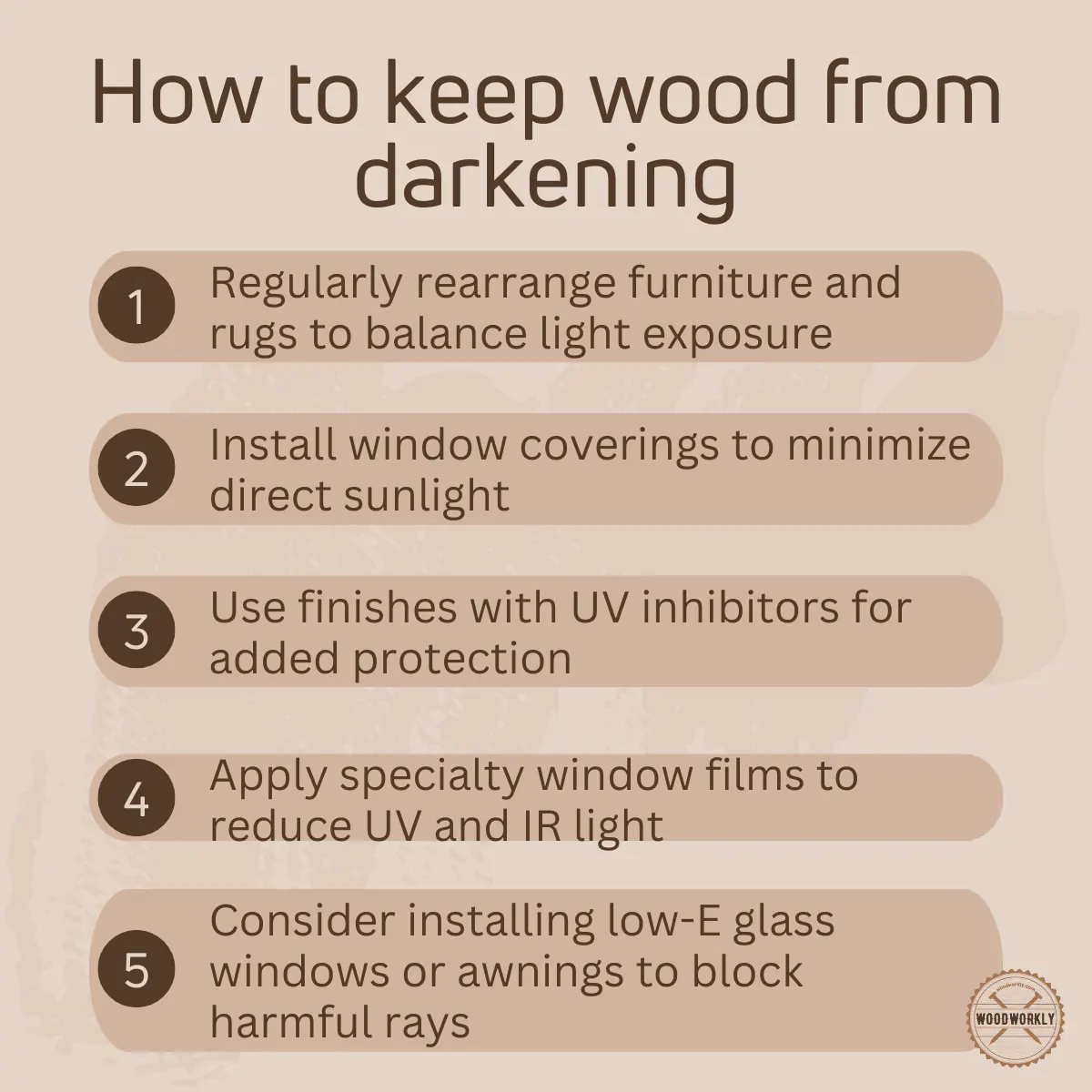
Woods That Change Color Due To Sunlight
Literally, all the wood changes color in the sun. The amount of color changing is the only difference between them.
Some wood turns darker in the sun, and some turn lighter.
So, hereby I have listed the most popular wood types and how they change color in the sun by leaving them under sunlight for at least a year.
| Wood Type | Color Change Due to Sunlight |
| Cherry Wood | Darkens |
| Mahogany | Darkens |
| Tigerwood | Darkens |
| Poplar | Darkens |
| Purpleheart | Darkens |
| Maple | Darkens |
| Red Oak | Lightens |
| Hickory | Lightens |
| Walnut | Lightens |
| Pine | Lightens |
| Cedar | Lightens |
| Teak | Darkens |
As you can all the wood types that we commonly used for making furniture and woodwork change color in the sun.
Some change quickly and some take time. However, at the end of the day, each one changes because of sunlight.
Some type of off sunlight enhance their appearance and they look more aesthetic after keeping under sunlight for a while.
For example, cheery wood gets a rich dark tone from having a light pale color tone after keeping it in sunlight and that’s become better in color than it used to be.
Similarly, mahogany will also turn into a nice-looking reddish-brown color tone in the sunlight.
Because of those reasons some people purposely keep their furniture and woodwork in the sun for a while until it reaches a noticeable color change they wish.
As a rule of thumb, darker wood tends to be lightened over time and lighter wood tends to be darkened over time under sunlight. Direct sunlight accelerates the process.
Now we have a clear idea about how raw wood/ timber changes color in the sunlight.
This same effect affects the furniture that you make from those wood.
I have noticed outdoor furniture turns darker or lighter over time faster than indoor furniture due to direct and indirect sunlight exposure levels.
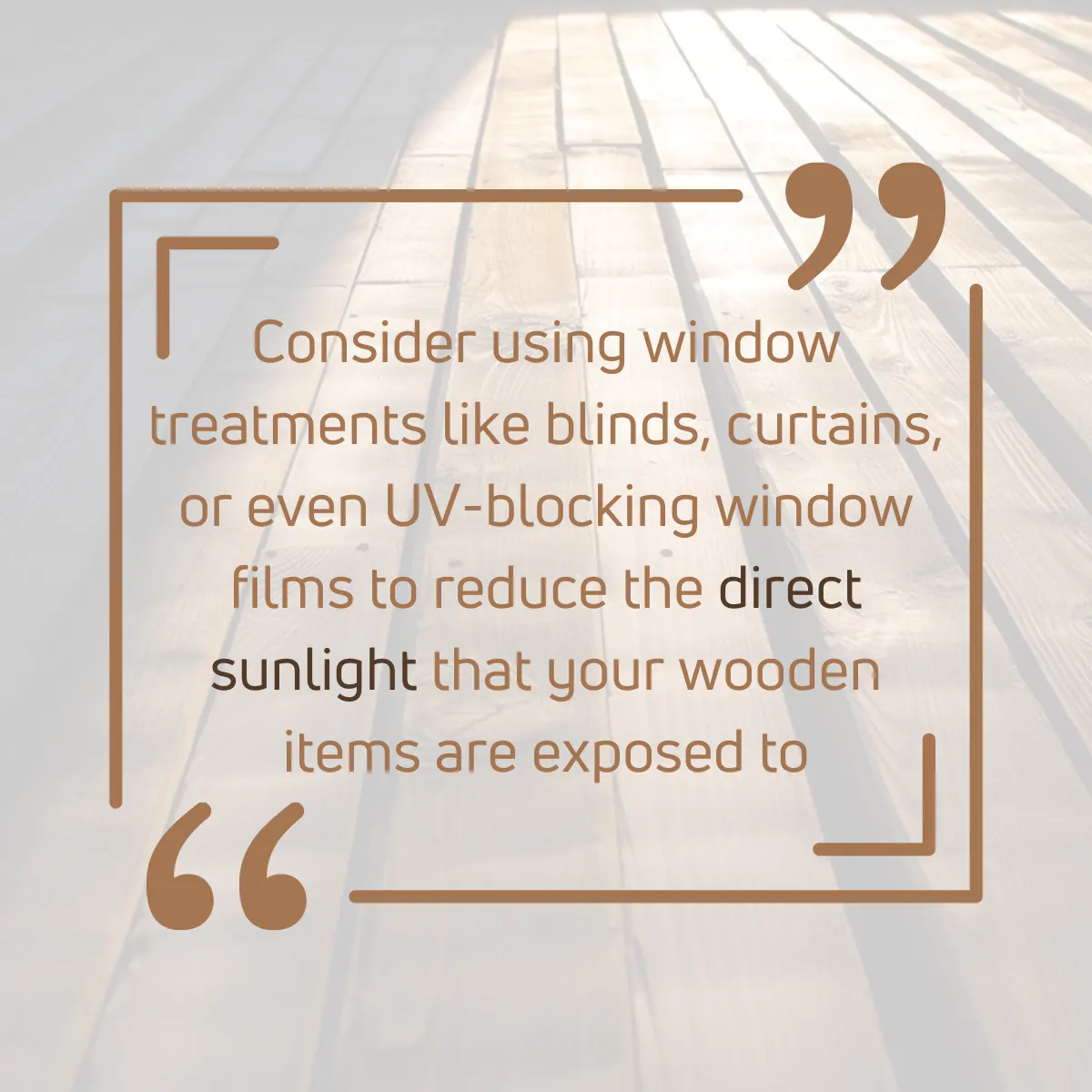
So, let’s have a look at how stained wood changes color after keeping them under sunlight for a long period of time.
Does Stained Wood Change Color in The Sun?
Same as unstained wood, stained wood also changes color over time when exposed to sunlight for a while.
The wet fresh look of stained wood will be gone under sunlight and result in a thicker finish.
This is because the dye color of stain cote will fade away under sunlight and the pigment layer will remain the same and suspended on top of the wood and give a thick dark color which is completely different from the original color of the stained wood.
How To Stop Wood from Darkening?
We can stop the wood from darkening by using sunblock to prevent our loved furniture or woodwork from exposing to sunlight and its UV light.
Sunblock prevents damage from the sunlight and makes your wood protected.
But you need to make sure the wood is maintained regularly and reapply the sunblock from time to time.
Otherwise, the sunblock will eventually go away under direct sunlight and the wood will start to darken slowly.
Here are the methods you can follow to stop wood from darkening,
- Apply finishes with UV inhibitors
- Avoid placing wooden furniture in direct sunlight
- Change the placement
- Window covering
- Add awnings
- Use low emissivity glass windows
Above solutions, you need to follow before your furniture gets darkened in the sunlight.
To follow the above steps, you can take actions like the given below.
Apply Finishes with UV Inhibitors
By applying finishers that contain UV inhibitors, they’ll prevent UV rays from getting into the wooden surface.
They have anti-UV agents to block the UV light in the sunlight.
The best finishes in the market with UV inhibitors are Lacquer and Linseed oil.
Applying lacquer is fast and easy when compared to linseed oil. It dries faster and the application is also so much easier.
Two coats of lacquer and linseed oil do the same job perfectly.
Even though linseed oil takes a much longer time than lacquer to dry completely, it not only gives sun protection but also protects the wood from water and moisture as well.
So in terms of protection linseed oil is better than lacquer. I highly recommend both to stop wood from darkening.
Avoid Placing Wooden Furniture in Direct Sunlight
By avoiding the placement of the furniture in direct sunlight, you’ll be clearly able to decrease its darkening. This only slows down the rate of darkening.
Even though you place the wooden furniture in places there is no direct sunlight, the indirect sunlight will also do the job during the daytime.
But much slower than placing wood in direct sunlight.
Change the Placement
Rearranging the placement of your woodwork from time to time not only it will slow down the darkening of the wood due to sunlight, but also stop the wood from looking weird with dark and light patches all over the surface which happens due to hitting sunlight unevenly all over the surface over time.
This will equalize UV radiation exposure to the wood and spread out darkening or fading evenly by giving a constant color all over the wood.
Window Coverings
By applying window coverings you’ll be able to stop hitting harmful UV light inside your house.
If you have hardwood floors that you don’t like to be darkened over time, window coverings are the best option.
The multi-layers of window coverings block the UV light and stop the wood from darkening.
Add Awnings
Awnings protect your house from reaching direct sunlight. No UV rays can hit household furniture because of awnings.
It not only gives good protection to the furniture from darkening but also enhances the appearance of the house as well.
Use Low Emissivity Glass Windows
Low emissivity glass windows which are also known as low E glass helps to prevent your furniture from hitting UV and IR light in the sunlight.
Unfortunately, this option is expensive. But it does the job perfectly.
Coatings in low emissivity glass windows limit the UV and IR radiations getting inside the house to keep them away from darkening.
So, that’s it, guys. Now you know how to prevent the darkening of wood due to sunlight.
But what if your furniture or wood project is already damaged due to sunlight? Are there any fixes? Don’t worry! I got you covered.
Now I’m going to share with you the methods that I have used to fix the projects that are already darkened due to the sunlight.
Just keep reading!
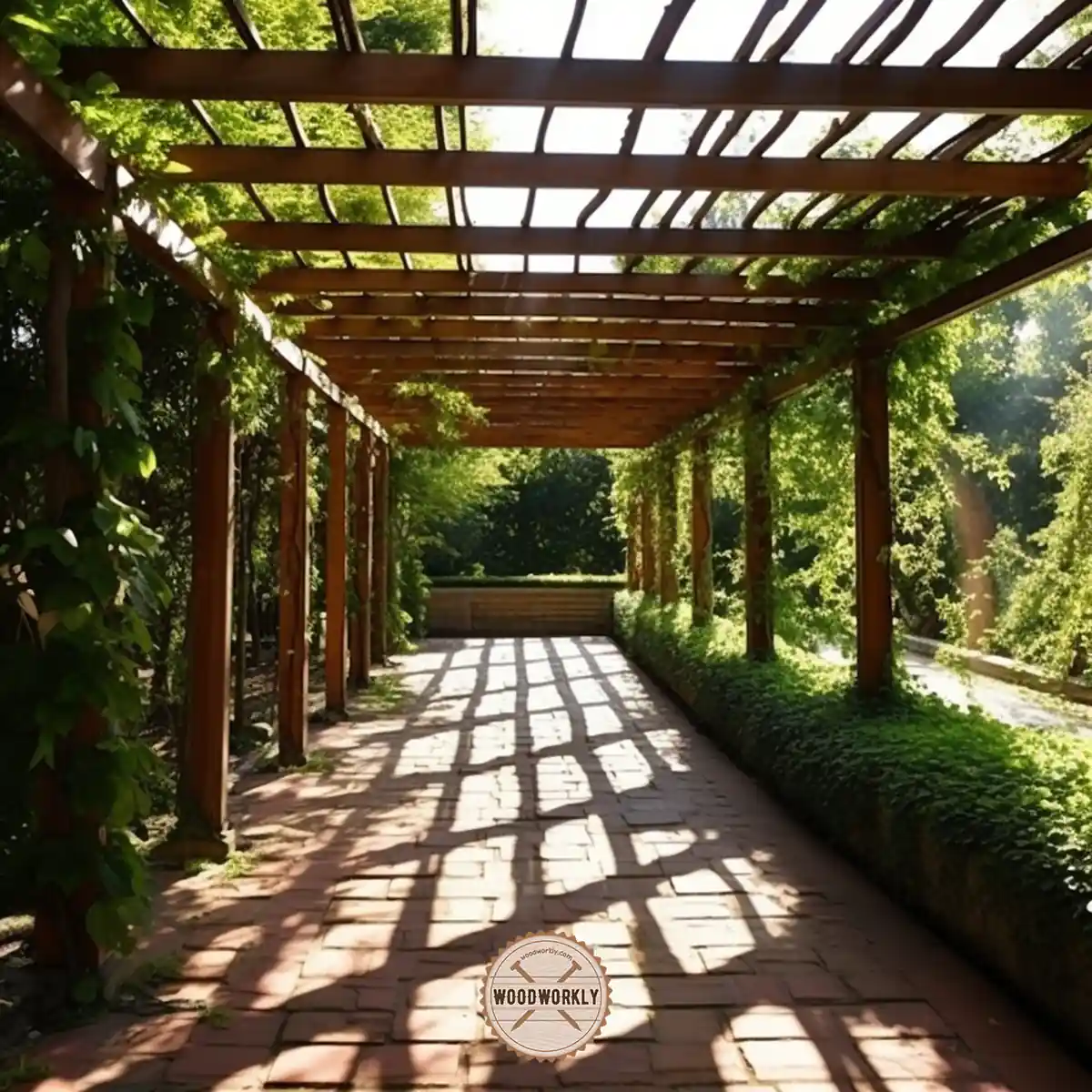
How Do You Fix Sun Darkened Wood?
We’ve all experienced it: that moment of surprise when we move a piece of furniture and see a stark contrast between the sun-exposed and the sheltered part of our wooden floor.
Sunlight can be a bit of a double-edged sword for wood – it brings out the beautiful grain patterns, but it can also lead to uneven darkening.
So, what can we do when our beloved wooden items have fallen victim to the sun’s rays?
Let’s walk through some practical tips on how to fix sun-darkened wood.
Balancing Light Exposure
Shifting Furniture and Rugs
This might sound too simple to work, but it can be surprisingly effective.
By rearranging your furniture and rugs, you allow the previously sheltered areas of your wood to catch up with the exposed parts in terms of darkening. This can help to even out the color across the whole room.
To make this a part of your routine, consider doing this every few months.
You might even find that a new arrangement freshens up the room!
If moving furniture is not feasible, consider removing rugs during sunnier months and placing them back in the darker winter months.
The Magic of Window Coverings
Use Drapes and Blinds
By limiting the amount of sunlight hitting your wood, you can significantly slow down the darkening process.
Window coverings such as drapes, curtains, shutters, and blinds are some of the best tools at your disposal.
If you’re concerned about keeping the room bright, try using blinds or louvers.
By angling the slats upwards, you can direct sunlight toward the walls and ceiling instead of the floor.
Going High-Tech with Motorized Screens
If convenience is a key factor for you, consider investing in motorized screens, shades, or blinds.
These can be programmed to extend during the hottest part of the day and retract afterward, allowing you to make the most of natural light without overexposing your wood.
Consider Upgrading Your Finish
Using UV Inhibitors
While no finish can completely stop the darkening process, some can slow it down significantly.
High-end water-based finishes are currently among the best at this.
They help reduce the ambering and fading of the wood, while also being extremely durable.
If you’re considering staining your wood, go for a pigment-based stain instead of a dye one.
Pigment stains are more colorfast, which means they’ll keep their color longer even under sun exposure.
Advanced Measures
Window Films and Awnings
For a more robust solution, consider installing window films.
These thin, multi-layered films are designed to cut down the UV and IR light while allowing visible light to enter your room.
Awnings can also help by blocking the sunlight before it even reaches your windows.
Low-E Glass Windows
If you’re in the process of a renovation or building a new home, low-E (low-emissivity) glass windows could be an excellent choice.
These windows have special coatings that limit the amount of UV and IR light that passes through, protecting your wooden items from excessive exposure.
When All Else Fails: Sanding and Refinishing
If the sun darkening is quite pronounced and the aforementioned methods aren’t helping, sanding and refinishing the wood might be your best option.
This process involves removing the top layer of the wood and applying a fresh finish, effectively resetting the clock on the sun darkening.
Remember, though: prevention is always better than cure.
If you opt for sanding and refinishing, make sure to implement some protective measures to prevent the same issue from recurring too quickly.
In conclusion, sun-darkened wood is a common issue, but one that we can definitely deal with.
Through a combination of rearrangement, protective measures, and regular maintenance, we can keep our wooden items looking their best for years to come.
Hope you learned everything you wanted to know about, Does sunlight darken wood.

Let’s answer some frequently asked questions.
FAQs
Is it possible to prevent sunlight from darkening wood?
While you can’t completely prevent sunlight from affecting the color of your wood, you can slow down the process significantly by limiting UV exposure with window coverings, using finishes with UV inhibitors, or applying specialty films to your windows that cut down on UV and IR light.
Does the type of finish on the wood affect how it reacts to sunlight?
Yes, the type of finish can influence how wood reacts to sunlight. For instance, oil-based polyurethane finishes can turn an orangey/yellow color over time under sunlight. On the other hand, high-end water-based finishes can help reduce ambering and fading.
What happens to the wood when it’s left in the sun?
Over time, sunlight can cause wood to either darken or lighten, depending on the wood species. Additionally, prolonged exposure to the sun can cause the finish on the wood to turn darker or yellowish.
Do all types of wood react to sunlight the same way?
No, different types of wood react to sunlight in different ways. For example, many tropical woods darken quickly under UV exposure, while many domestic woods bleach and lighten over time.
Can UV protective window films prevent wood darkening?
UV protective window films can drastically reduce the amount of UV and IR light reaching your wooden items, thereby slowing down the darkening process. However, they cannot entirely prevent it.
What if my wood floors are already sun-darkened?
If your wood floors are already sun-darkened, you can help blend the color by rearranging furniture and rugs. In more severe cases, sanding and refinishing the floors may be necessary.
Are there any long-term solutions to prevent wood darkening?
Long-term solutions include using low-E glass windows that limit the amount of UV and IR light, using high-quality water-based finishes, and applying pigment-based stains that are more colorfast.
Did I cover all you wanted to know about: Does Sunlight Darken Wood?
In this post, we looked at does sunlight darken wood and why does it happen.
Furthermore, we have discussed what wood changes color in the sun and why do some wood fades and bleaches out but some darkens after keeping under sunlight for a while.
Sunlight can both darken and lighten wood depending on the species. For instance, many exotic woods like Brazilian Cherry darken rapidly under UV exposure, while domestic woods like Red Oak tend to bleach and lighten. The type of finish also plays a part in the wood’s reaction to sunlight.
As a woodworker, my suggestion is to never leave your woodwork or furniture unfinished.
With proper finishing, you’ll be able to stop the wood from darkening and keep the tone of the wood originally and freshly looked over the years with proper maintenance.
Hope you’ve learned lots of new things about how sunlight affects the color of your wooden furniture.
So let’s apply things we learned to your nice-looking furniture and woodwork to keep them away from darkening. Let’s give it a try!
After removing the protective MDF strips from my stairwell treads (installed prior lockdowns), I discovered a distinct colour difference, as the strips didn’t cover the entire tread. I now wish to use a clear sealer, but I want to achieve even colouration.
Should I sand, let it even out before sealing (might take a long time), or any other ideas?
I appreciate your input 🙂
Hi Kris!
Thank you for the comment. Unfortunately, the best thing to do is sand and let the surface even out before sealing even though it takes time. As an alternative option, you can apply wood stain first to minimize the color difference and then apply a sealer on top of that.
Great information! Thank you. I’m considering using Silver Birch with a natural finish for kitchen cabinets. What are your thoughts? I’m looking for a light wood that doesn’t have much grain pattern and won’t yellow like maple does overtime.
Any and all suggestions appreciated!
Hi Barb!
Thank you for the feedback.
Silver Birch develops a yellowish-red tint with age. So, better to apply a finisher with UV inhibitors for better protection from Sunlight.